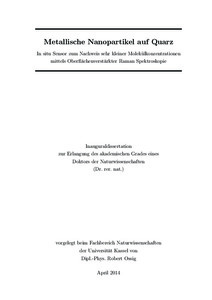| dc.date.accessioned | 2014-08-20T11:45:50Z | |
| dc.date.available | 2014-08-20T11:45:50Z | |
| dc.date.issued | 2014-08-20 | |
| dc.identifier.uri | urn:nbn:de:hebis:34-2014082045907 | |
| dc.identifier.uri | http://hdl.handle.net/123456789/2014082045907 | |
| dc.language.iso | ger | |
| dc.rights | Urheberrechtlich geschützt | |
| dc.rights.uri | https://rightsstatements.org/page/InC/1.0/ | |
| dc.subject | Nanopartikel | ger |
| dc.subject | Raman | ger |
| dc.subject | SERS | ger |
| dc.subject | Sensor | ger |
| dc.subject.ddc | 530 | |
| dc.title | Metallische Nanopartikel auf Quarz | ger |
| dc.type | Dissertation | |
| dcterms.abstract | This work presents the developement of an chemically stable and easy to produce in situ sensor for fast and reliable detection of polycyclic aromatic hydrocarbons (PAH) in low nanomolar concentrations. Metallic nanoparticles on dielectric substrates werde used for the rst time with surface enhanced Raman spectroscopy (SERS) in combination with shifted excitation Raman difference spectroscopy (SERDS).
The preparation of the metallic nanoparticle ensembles with Volmer-Webergrowth is described first. The nanoparticles are characterized with both, optical spectroscopy and atomic force microscopy. The morphological properties of the nanoparticle ensembles are de ned by the mean axial ratio (a/b) and the mean equivalent radius (R Äq), respectively.
The prepared and characterized nanoparticles were then used for intensive Raman spectroscopy measurements. Two sophisticated diode laser systems were used in cooperation with the TU Berlin, to carry out these experiments. The first step was to establish the ideal combination of excitation wavelength of the diode laser and the maximum of the surface plasmon resonance of the nanoparticle ensembles.
From these results it was deduced, that for an optimum Raman signal the plasmon resonance maximum of the nanoparticle ensemble has to be red-shifted a few nanometeres in respect to the excitation wavelength. Different PAHs werde detected in concentrations of only 2 and 0.5 nmol/, respectively. Furthermore, the obtained results show an excellent reproducability.
In addition the time dependence of the Raman signal intensity was investigated. The results of these measurements show, that only 2 minutes after placing the substrates in the molecular solution, a detectable Raman signal was generated. The maximum Raman signal, i.e. the time in which the molecular adsorption process is finished, was determined to about 10 minutes. In summary it was shown, that the used metallic nanoparticle ensembles are highly usable as substrates for SERS in combination with SERDS to detect PAHs in low nanomolar concentrations. | eng |
| dcterms.accessRights | open access | |
| dcterms.alternative | In situ Sensor zum Nachweis sehr kleiner Molekülkonzentrationen mittels Oberflächenverstärkter Raman Spektroskopie | ger |
| dcterms.creator | Ossig, Robert | |
| dc.contributor.corporatename | Kassel, Universität, FB 10, Mathematik und Naturwissenschaften, Institut für Physik | |
| dc.contributor.referee | Hubenthal, Frank (PD Dr.) | |
| dc.contributor.referee | Ehresmann, Arno (Prof. Dr.) | |
| dc.subject.pacs | SERS | ger |
| dc.subject.pacs | nanoparticles | ger |
| dc.subject.pacs | Raman | ger |
| dc.subject.pacs | sensor | ger |
| dc.subject.swd | Nanopartikel | ger |
| dc.subject.swd | Raman-Spektroskopie | ger |
| dc.subject.swd | Oberflächenverstärkter Raman-Effekt | ger |
| dc.subject.swd | Sensor | ger |
| dc.date.examination | 2014-07-17 | |

